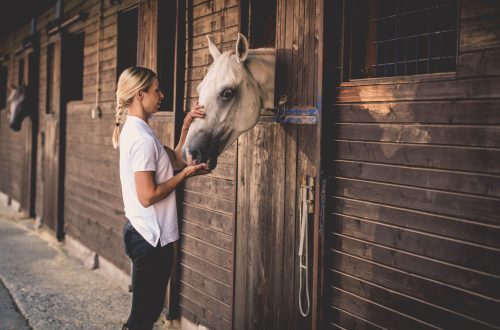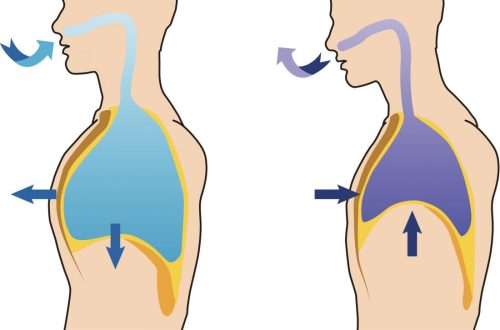
About security in the details
About security in the details
“… They are uncomfortable in the middle, and dangerous at the edges,” said Sir Winston Churchill, Prime Minister of Great Britain, about horses. Let’s discard the first part of the phrase, which is quite controversial, and deal with the second. And here it is impossible not to recognize the truth: with its reputation as a friendly creature, the horse is an extremely dangerous 500-kilogram creature. Moreover, it poses a danger both for you and for itself, for other horses and people who are in close proximity to it (we will even turn a blind eye to the damage to the stable equipment that may meet on the way, for example, from a horse that has run away from you) .
This article is addressed not only to beginners, but also (to an even greater extent) to the “oldies” who tend to close over time eyes on a lot of safety rules, but they, like traffic rules, are not just written like that …
How to reduce the risk of accidents in the stable? I will not talk about the rules that are repeated over and over again (wear a helmet, drive around in the arena with your left shoulders, etc.). I propose to consider from the point of view of safety our routine actions, which make up the usual stable life.
Everything I describe below is my point of view based on personal experience. I do not dispute the existence of other points of view, other methods. I’m happy to hear other people’s thoughts on this matter.
So, What do we encounter every day when communicating with horses? How to make all the processes accompanying this communication comfortable and safe for yourself, the horse and others?
First of all, I want to remind you that horses should be handled in special riding shoes or (if there is none) in other shoes that protect the legs. Flip flops, sandals, “barefoot on sawdust/sand” can do you a disservice: not all horses are equally neat, and if you step on your bare foot, you can be left with a broken toe.
It is sometimes argued that a helmet should be worn while in the stables (not just during riding). However, nowhere – neither in Russia, nor in Ukraine, nor in Europe, nor in Africa, have I seen anything like this. However, I would like to separately note that when working on a lunge or freehand with some horses (aggressive or not yet trained young specimens with “lower adequacy”), a helmet can come in handy – if the horse makes a jerk, you risk injuring your head when you fall, the same – And in the event of a surprise attack…
Well, in front of you…
Dennik
We go into the stall and take the horse out
You can enter the stall only by first calling the horse.
If the horse is lyingshe must rise. If it does not rise, call the instructor and let her help you. If you are one of those who “ate the dog”, go in, wake up the horse, but it is better to leave when it starts to rise. The horse may want to do a couple of warm-up leg swings, and you don’t want one of them flying in your direction. Of course, many break this rule, mainly because of the haste and the belief that they know the habits of the horse. But it happens that an unloaded gun shoots … I know, many will say that they regularly go to the horse when it lies, sit next to / above, and nothing happens. Yes. I do it myself. Why? Because “I know this horse” 😉 But now we are talking about the rules, so be vigilant and careful.
So, the horse paid attention to you, but for some reason worth to you “not a face”. No need to come up and slap it in a friendly manner on the sirloin. Call more persistently, rustle a bag of sweets, and, most likely, she will get up as she should. Most of the horses themselves turn towards the entrance. If everyone knows the harsh temper of a particular horse, and it is she who still won’t turn around, stubbornly blocking your entrance with her croup, you don’t need to try with a whip / broom (yes, I saw this) to beat her through the stall grate, trying to turn. The horse assumes its “defensive” position only when it sees on the horizon a man approaching the stall with a halter in his hands. Most often, it needs behavior adjustments, but this is a topic for another article.
If you are a beginner, ask an instructor for help. If you are experienced and there is a new horse in front of you, work on its behavior. If your horse suddenly starts acting like this, it’s not a good sign to seriously consider. The main thing is not to scare the horse even more.
Now you’re inside and the horse is facing you. Remember, you should never latch the stall door behind you. You can cover for her, but you should always have the option to leave!
You have a halter and a lead lead in your hands. Without making sudden movements, stand at the left shoulder of the horse and carefully put the halter on it. Fasten the lead. Be sure to check if everything is fixed. Often children, beginners, and even experienced riders in a hurry, especially if the horse raises its head high, do not check the right (opposite) side, as a result, the halter hangs on one ear, the horse risks losing it, and you risk losing the horse.
Some equestrians unhook the horses in the stall. From a security point of view, this is not entirely true. Such manipulations should be done at interchanges.
Taking the horse out of the stall, open the door as wide as possible.
Lead the horse ONLY by the lead, even if the junctions are a meter away from you. The horse can get scared, break free, and you will not have a chance to stop it. You can even break your fingers if she jerks her head unsuccessfully. A horse running freely along the stable aisle can harm both itself and the people and horses around it. It’s better not to bring it up.
Leading the horse out of the stall, go ahead, on the left. Try to hold her so that she does not hit her sides, legs on the ledges of the doors. Do not make sharp turns or turns on the spot – this can damage the horse’s shoulders. In addition, she can slip, and as a result – fright, fall, injury …
We start in the diary
Getting the horse into the stall, we also open the doors as wide as possible.
We go into the stall, keeping in front and to the left of the horse. The horse should not run into the stall, overtaking or pushing you away. Make sure she doesn’t hit the door.
Entering the stall, lead the horse in a circle and put the muzzle towards you, you yourself should stand at the exit. Don’t jerk the lead or twist the horse too hard. Close the door and carefully remove the halter from the horse. Treat her to something delicious and go out. Don’t forget to latch the door.
Never remove the halter from the horse in front of the stall, do not even unfasten it. No need to teach her to go into the stall on her own. Horses quickly learn to “fly in” through an open door, and then “fly out” of it when they exit. The horse can hit, get scared, turn around sharply and run away.
Not often, but there are horses that rush along the aisle, dragging an accompanying person behind them, and then, like mad, fly into the stall. The more you hold them back, the more intense the panic seems to be. This behavior needs to be corrected to build trust and respect. If you are a beginner, just ask someone who can handle it to get a horse.
passage
Now let’s talk about how to lead the horse down the aisle.
We hold the chombur in the right hand if you are right-handed, and in the left if you are left-handed.
If you are leading a horse with a bridle (wherever you do) you can either fasten the lead lead to the snaffle ring, or remove the rein from the neck and lead the horse by the reins:
if you leave the rein around the neck, it will be easier for the horse to break free and run away:
Note: if the martingale is on the horse, then the reins are not removed from the neck!
Lead your horse down the center of the passage. Make sure that the horses standing in the stalls cannot reach it and bite it. If you know that on your way you will meet a lover to attack passing comrades, first close such a horse the upper grate of the stall (if possible) or ask an assistant (for example, a groom) to distract the bully. This must be done carefully so as not to provoke even more aggression and not to scare the horses.
Ask to remove (or pre-remove yourself) from the aisle left there wheelbarrows and other bulky items that may prevent you from passing.
If another horse is being led down the aisle towards you, diverge with your left shoulders (you pass next to the other leader, the horses are on the edge of you).
If there is another horse in the aisle at the interchanges, ask you to let it pass if possible. The person who is next to the horse must unfasten the right tie (if he is standing with his back to you), move the horse to the left side, stand at his right side near the shoulder (if he is standing with his back to you) and hold him by the unfastened tie or lead . We always part so that you pass next to the person, and the horses are on either side of you.
A nervous or aggressive horse, standing at interchanges and blocking the path, is better to ask for a short stall (if possible).
Never try to pass under an interchange or unfasten a standing horse yourself if no one is nearby! Wait and ask someone to help you.
interchanges
The first thing I want to say about interchanges is that they should be with safe carabiners (panic carabiners). This is a must! Some equestrians at the junctions also use special halters – made of leather or with a leather nape strap. What for? If the horse panics, tries to escape, let the halter and interchanges be better torn than it injures the head and (or) neck (a nylon halter cuts the skin very well), and, having fallen, also the legs and so on. For the same reasons, you cannot use a “rope” halter, tying it to interchanges. In this halter, even grazing horses is not recommended, not to mention letting the horse out for a walk in it in the paddock.
Putting a bridle on the horse, we unfasten the halter and fasten it quickly around the horse’s neck (the carabiner must be safe).
If the horse is already in the bridle and you need to keep him in the junctions for a while, put on over him halter
Halter – twist and secure with a chinstrap halter. If the rein falls, the horse can step on it or get tangled, break the bridle, or worse, injure the mouth!
It is strictly forbidden to cling the denouement to the snaffle ring! This rule must not be violated under any circumstances.
Never leave a halter lying in the aisle when you have gone into the arena with your horse. Hang it in place.
Manege
The horse should be mounted in the center of the arena, without interfering with other riders.
Well, if it is possible to sit in the saddle from a stand (even a simple stump can do) or a special ladder:
This way you won’t make the horse uncomfortable when you pull the saddle down (the pads of the saddle lie on either side of the horse’s spine and when you put your foot in the stirrup and push up, they pull on the withers and put pressure on the spine):
Not a particularly pleasant sensation, especially for a horse with a sensitive back.
If there is no stand, ask an assistant to hold the saddle on the right side of the stirrup so that you do not pull it on its side.
When sitting in the saddle, first lower both stirrups down. If the horse gets scared or just runs, it will be easier for you to catch the right stirrup.
If the rider is facing the side of the horse before mounting, his sock will subsequently rest against her stomach:
The rider will be less likely to stop the horse if he moves or refuses to stand still – after the first step of the horse, the rider will be at his hip!
If you stand facing in the direction against the movement of the horse, the toe will not rest against its stomach, but will become parallel to the side:
If the horse starts moving at the rider in this position, there will be more opportunities to stop it.
Try not to hit the horse with your right foot on the rump and get into the saddle gently – no need to fall there. This can excite or frighten the horse.
If you need to adjust the length of the stirrups, this can be done in two ways:
1. Do not throw stirrups. With one hand we hold the selected rein, we put the leg forward behind the wing, with our free hand we adjust the stirrups:
2. We do not throw stirrups. With one hand we hold the selected rein, we take the leg at the knee and lower legs a little to the side and back, with our free hand we adjust the stirrups:
When tightening the girth, also do not drop the reins, learn to do everything with one hand. If you drop the stirrup or the reins, you run the risk of getting into trouble if the horse decides to run.
When dismounting, do not allow the situation where your left foot is in the stirrup and your right foot is on the ground. You don’t need to be told what will happen to you if the horse runs. Before descending, take both feet out of the stirrups, swing the right foot over the croup and slide down. Don’t leave the occasion hanging around your neck. You are always in control of the situation.
Freelance situations in the arena occur when one of the riders falls off the horse.
If you are on horseback and see that a horse is running around the arena without a rider, stop your horse and listen to the trainer’s advice. Most likely you and other riders will be asked to group closer to the center of the arena and stay there until the horse is caught. “Hiding” in a corner, you can get hit by a “ownerless” horse running past.
If you fell, then, again, listen to the coach. Previously, the rider was required in no case not to throw the reins. Now, however, the safety of the rider comes to the fore: while holding the horse, you can easily get under the hooves, so no one will condemn the one who threw the reins.
Another point is important. It is believed that after a fall, it is best for the rider to immediately get back on horseback in order to forget the fear of falling and not earn a “complex”. The landing after the fall is also necessary for the horse – so he will not learn the lesson that the fallen rider is the end of training.
There is an important exception to this good tradition: if you have fallen seriously and feel really bad, do not be a hero. Take care of yourself, and ask someone else to sit on the horse.
Conversations
Talking with friends, and especially on the phone, distracts the horse and disturbs other riders and trainers. In the case of the phone, it is also not safe. Leave the talk for later. In addition, a ringing phone, if it remains indifferent to your already accustomed horse, can frighten a horse passing by.
Levada
When taking the horse to the levada, remain vigilant. The horse may anticipate the game and the free “flight” and begin to play along.
We bring to the Levada only on a chombura.
When you have entered the levada, close the gate without locking it, and turn the horse around to face you. Running away, she can play along and accidentally hit you.
It is not necessary to let the horse out by unfastening the lead rope before entering. Running through the gate, the horse can hit and injure himself.
Some horses have a bad habit of jumping out of their hands when entering the levada. There are horses that “start” as soon as they hear the click of a carbine. This behavior needs to be corrected – you will have to work on respect.
As you lead your horse out of the levada, gently guide him through the gate. Try not to twist the horse abruptly in place as you close them behind you.
Blanket
Handling the blanket requires special care. You can put it on and take it off both in the stall and at the junctions.
When removing the blanket, carefully unfasten the underbelly straps. They can hit the horse’s legs with metal elements and scare it.
It is usually recommended to fasten the fasteners on the chest first and unfasten them in the middle. If you fasten the belly straps first, the horse can walk, and the blanket that is not fastened in front will slide back, which will scare the horse even more, and here it’s not far from problems.
When removing, pull the blanket along the coat, from the withers to the tail. Don’t pull it over your back.
Try not to make sharp swings with your hands and do not throw the blanket with effort on your back (if it is winter, it weighs a lot).
Be careful with unfamiliar horses. There are horses that have not encountered this boon of civilization – they can not only be surprised, but also scared.
Pasture
I’m not talking about free grazing now, but about a friendly gesture on our part towards the horse. Many people like to herd their pets after work. From a security point of view, everything is simple here.
Do not leave your horse unattended if you are grazing it on club grounds. Yes, I saw this as well – an example of “friendship-NH” and confidence that the horse will not go anywhere. Then everything worked out.
The horse may step on the lunge/lead lead. Someone reacts to this normally, but someone panics. Try not to let this happen. You can throw the lead on the right side over the back of the horse’s head or back. So she will not step on the hanging end.
It is better to graze in a halter. The horse will handle the grass and snaffle, but in this case, loosen the noseband as much as possible and fasten the rolled rein under the chinstrap (or unfasten it altogether).
Do not sit on a grazing horse. Children often do this, but adults do too. It’s not safe, but besides – think about the horse! You prevent the hard worker from eating. Have a conscience!
Take care of your horses and take care of yourself. Perhaps the extra five minutes it takes you to comply with safety regulations will help you avoid an accident.
Valeria Smirnova.
In the photographs Anastasia and Myopia. KSK “Happy horse”, Krivoy Rog (Ukraine).
- konyushnya2012 November 20 2017 city
Almost everything is true, except for adjusting the stirrups on horseback without removing the legs from them. This is dangerous. It is better (if force majeure) to simply plop off the horse than to get your foot stuck in the stirrup, so it is better to throw them. Answer
- Valeria Smirnova 9th of December 2017
Based on this logic, it’s better not to pick up stirrups at all, so as not to get stuck if something happens. If the horse runs while adjusting the length of the stirrups, you will put your foot back in place and take control of the situation, you will not have to try to maintain balance and catch the stirrup at the same time. Answer





